Impact of Influencing Factors on CO2 Emissions in the Yangtze River Delta during Urbanization
Abstract
1. Introduction
1.1. Research Background
1.2. Contributions of this Paper
2. Methodology
2.1. STIRPAT Model
2.2. Vector Autoregression Model
2.3. IRF and VD
2.4. SVM
3. Study Area and Data Source
3.1. Study Area
3.2. Data Source
3.2.1. Population
3.2.2. Urbanization Rate
3.2.3. GDP per capita
3.2.4. Energy Intensity
3.2.5. CO2 Emission
4. Empirical Results
4.1. Unit Root Test
4.2. Johansen Co-Integration Test
4.3. IRF Results
- One standard deviation shock in energy intensity will result in a sharp increase of CO2 emissions, reaching its maximum in the second period. After that, CO2 emissions ill decrease rapidly and finally stagnate after the eighth period.
- CO2 emissions in YRD showed a positive response to GDP per capita both in the short and long term; however, the intensity of response reduced over time. The response trajectory was similar to the shock in energy intensity on CO2 emissions. However, the duration of impact was longer than that from energy intensity. The CO2 emissions level did not achieve stagnation before the tenth period.
- In response to shocks coming from the population, the CO2 emissions increased in the first two periods and then decreased, with the reaction turning to a negative response in the third period, slightly fluctuating between the fourth period and fifth period, and eventually stagnating after that.
- The reaction of CO2 emissions to shock in urbanization maintained a positive response state firstly and reached its maximum in the second period. Then, the response gradually decreased and reached its largest negative value at the end of the third period, then maintained a very small negative value between the fourth and fifth period and eventually stagnating.
4.4. VD Results
4.5. Prediction of CO2 Emissions in YRD
4.5.1. Construction of the SVM Model
4.5.2. Prediction Results of CO2 Emissions
5. Discussion
5.1. The Overall Change in CO2 Emission Level
5.2. The Relationship between CO2 Emission and Urbanization Rate
5.3. The Relationship between CO2 Emission and Energy Intensity
5.4. The Relationship between CO2 Emission and GDP per Capita
5.5. The Relationship between CO2 Emission and Population Size
6. Conclusions
- Johansen cointegration test results provided evidence of the existence of the cointegration relationship among urbanization, population, economy growth, energy intensity, and CO2 emissions.
- During the urbanization process, YRD’s CO2 emissions continued increasing and was predicated to further increase in the long term. However, the contribution of urbanization to emissions continued to decline in the long term. The dynamic shock of urbanization on emissions in the long term even changed to negative. These findings mean that there may exist an inverted U-shaped relationship between urbanization and CO2 emissions when the turning point comes. Therefore, there is no need for YRD’s government to sacrifice the urbanization process for emission reduction. This is different from the suggestion that China should slow down the process of urbanization in order to combat CO2 emission (Zhang and Lin, 2012) [7].
- All the model results indicated that energy intensity had the greatest impact on YRD’s CO2 emissions. Therefore, increasing low-carbon technology levels and lowering energy intensity is still the main task of the transition to a low-carbon economy in YRD. First, the efficiency of energy utilization should be enhanced. YRD can fully take advantage of high-level foreign investment itself to accelerate the introduction, digestion, and absorption of advanced low-carbon technologies, establish bilateral or multilateral energy efficiency cooperation plans, and promote the improvement of energy efficiency. Second, the energy structure should be further adjusted by increasing the proportion of non-fossil energy consumption. The coal consumption should be controlled, and economic and effective clean coal technologies should be applied. Moreover, clean and renewable energy sources, such as wind, solar, biomass, geothermal, and water, should be vigorously developed. The governments should actively promote the construction of nuclear energy in Zhejiang and Jiangsu.
- The contribution of GDP per capita to CO2 emissions is higher than the population and urbanization rate. However, the finding related to GDP per capita, which needs to be emphasized most, is its fastest growth rate contribution. This indicates that the economic development in YRD is always accompanied by large emissions, and this trend is predicted to last in the future. The Kuznets curve does not exist in the current YRD.
- The results showed that population contributed the least to YRD’s CO2 emissions, far below the three other factors, and the impact was negligible. This means that the policies related to population control in YRD can hardly achieve emission reductions.
Author Contributions
Funding
Conflicts of Interest
References
- Al-Mulali, U.; Fereidouni, H.G.; Lee, J.Y.M.; Sab, C.N.B.C. Exploring the relationship between urbanization, energy consumption, and CO2 emission in MENA countries. Renew. Sustain. Energy Rev. 2015, 23, 107–112. [Google Scholar] [CrossRef]
- Chikaraishi, M.; Fujiwara, A.; Kaneko, S.; Poumanyvong, P.; Komatsu, S.; Kalugin, A. The moderating effects of urbanization on carbon dioxide emissions: A latent class modeling approach. Technol. Forecast. Soc. Chang. 2015, 90, 302–317. [Google Scholar] [CrossRef]
- International Energy Agency. World Energy Outlook; IEA: Paris, France, 2008. [Google Scholar]
- National Bureau of Statistics of China. China Statistical Yearbook 2018; China Statistics Press: Beijing, China, 2018.
- Gregg, J.S.; Andres, R.J.; Marland, G. China: Emissions pattern of the world leader in CO2 emissions from fossil fuel consumption and cement production. Geophys. Res. Lett. 2008, 35, 135–157. [Google Scholar] [CrossRef]
- Shen, L.; Cheng, S.; Gunson, A.J.; Wan, H. Urbanization, sustainability and the utilization of energy and mineral resources in China. Cities 2005, 22, 287–302. [Google Scholar] [CrossRef]
- Zhang, C.; Lin, Y. Panel estimation for urbanization, energy consumption and CO2 emissions: A regional analysis in China. Energy Policy 2012, 49, 488–498. [Google Scholar] [CrossRef]
- Lin, S.; Wang, S.; Marinova, D.; Zhao, D.; Hong, J. Impacts of urbanization and real economic development on CO2 emissions in non-high income countries: Empirical research based on the extended STIRPAT model. J. Clean. Prod. 2017, 166, 952–966. [Google Scholar] [CrossRef]
- National Bureau of Statistics of China. China Energy Statistics Yearbook 2018; China Statistics Press: Beijing, China, 2018.
- Bekhet, H.A.; Othman, N.S. Impact of urbanization growth on Malaysia CO2 emissions: Evidence from the dynamic relationship. J. Clean. Prod. 2017, 154, 374–388. [Google Scholar] [CrossRef]
- Martinez-Zarzoso, I.; Maruotti, A. The impact of urbanization on CO2 emissions: Evidence from developing countries. Ecol. Econ. 2011, 70, 1344–1353. [Google Scholar] [CrossRef]
- Shi, X.; Li, X. Research on three-stage dynamic relationship between carbon emission and urbanization rate in different city groups. Ecol. Indic. 2018, 91, 195–202. [Google Scholar] [CrossRef]
- Madlener, R.; Sunak, Y. Impacts of urbanization on urban structures and energy demand: What can we learn for urban energy planning and urbanization management? Sustain. Cities Soc. 2011, 1, 45–53. [Google Scholar] [CrossRef]
- Yang, Y.; Zhao, T.; Wang, Y.; Shi, Z. Research on impacts of population-related factors on carbon emissions in Beijing from 1984 to 2012. Environ. Impact Assess. Rev. 2015, 55, 45–53. [Google Scholar] [CrossRef]
- Wang, Z.; Cui, C.; Peng, S. How do urbanization and consumption patterns affect carbon emissions in China? A decomposition analysis. J. Clean. Prod. 2019, 211, 1201–1208. [Google Scholar] [CrossRef]
- Azizalrahman, H.; Hasyimi, V. A model for urban sector drivers of carbon emissions. Sustain. Cities Soc. 2019, 44, 46–55. [Google Scholar] [CrossRef]
- Wang, Y.; Li, L.; Kubota, J.; Han, R.; Zhu, X.; Lu, G. Does urbanization lead to more carbon emission? Evidence from a panel of BRICS countries. Appl. Energy 2016, 168, 375–380. [Google Scholar] [CrossRef]
- Sharma, S.S. Determinants of carbon dioxide emissions: Empirical evidence from 69 countries. Appl. Energy 2011, 88, 376–382. [Google Scholar] [CrossRef]
- Zhang, N.; Yu, K.; Chen, Z. How does urbanization affect carbon dioxide emissions? A cross-country panel data analysis. Energy Policy 2017, 107, 678–687. [Google Scholar] [CrossRef]
- Yao, X.; Kou, D.; Shao, S.; Li, X.; Wang, W.; Zhang, C. Can urbanization process and carbon emission abatement be harmonious? New evidence from China. Environ. Impact Assess. Rev. 2018, 71, 70–83. [Google Scholar] [CrossRef]
- Zhu, H.-M.; You, W.-H.; Zeng, Z.-F. Urbanization and CO2 emissions: A semi-parametric panel data analysis. Econ. Lett. 2012, 117, 848–850. [Google Scholar] [CrossRef]
- Shahbaz, M.; Chaudhary, A.; Ozturk, I. Does urbanization cause increasing energy demand in Pakistan? Empirical evidence from STIRPAT model. Energy 2017, 122, 83–93. [Google Scholar] [CrossRef]
- Sheng, P.; Guo, X. The Long-run and Short-run Impacts of Urbanization on Carbon Dioxide Emissions. Econ. Model. 2016, 53, 208–215. [Google Scholar] [CrossRef]
- Wu, Y.; Shen, J.; Zhang, X.; Skitmore, M.; Lu, W. Reprint of: The impact of urbanization on carbon emissions in developing countries: A Chinese study based on the U-Kaya method. J. Clean. Prod. 2017, 163, S284–S298. [Google Scholar] [CrossRef]
- Yang, L.; Xia, H.; Zhang, X.; Yuan, S. What matters for carbon emissions in regional sectors? A China study of extended STIRPAT model. J. Clean. Prod. 2018, 180, 595–602. [Google Scholar] [CrossRef]
- Ouyang, X.; Gao, B.; Du, K.; Du, G. Industrial sectors’ energy rebound effect: An empirical study of Yangtze River Delta urban agglomeration. Energy 2018, 145, 408–416. [Google Scholar] [CrossRef]
- Li, J.; Huang, X.; Kwan, M.-P.; Yang, H.; Chuai, X. The effect of urbanization on carbon dioxide emissions efficiency in the Yangtze River Delta, China. J. Clean. Prod. 2018, 188, 38–48. [Google Scholar] [CrossRef]
- Song, M.; Guo, X.; Wu, K.; Wang, G. Driving effect analysis of energy-consumption carbon emissions in the Yangtze River Delta region. J. Clean. Prod. 2015, 103, 620–628. [Google Scholar] [CrossRef]
- Zhu, X.-H.; Zou, J.-W.; Feng, C. Analysis of industrial energy-related CO2 emissions and the reduction potential of cities in the Yangtze River Delta region. J. Clean. Prod. 2017, 168, 791–802. [Google Scholar] [CrossRef]
- Ehrlich, P.R.; Holdren, J.P. Impact of population growth. Science 1971, 171, 1212–1217. [Google Scholar] [CrossRef]
- Dietz, T.; Rosa, E.A. Effects of population and affluence on CO2 emissions. Proc. Natl. Acad. Sci. USA 1997, 94, 175–179. [Google Scholar] [CrossRef]
- York, R.; Rosa, E.A.; Dietz, T. STIRPAT, IPAT and ImPACT: Analytic tools for unpacking the driving forces of environmental impacts. Ecol. Econ. 2003, 46, 351–365. [Google Scholar] [CrossRef]
- Sims, C.A. Macroeconomics and Reality. Econometrica 1980, 48, 1–48. [Google Scholar] [CrossRef]
- Hao, Y.; Wang, L.; Zhu, L.; Ye, M. The dynamic relationship between energy consumption, investment and economic growth in China’s rural area: New evidence based on provincial panel data. Energy 2018, 154, 374–382. [Google Scholar] [CrossRef]
- Talbi, B. CO2 emissions reduction in road transport sector in Tunisia. Renew. Sustain. Energy Rev. 2017, 69, 232–238. [Google Scholar] [CrossRef]
- Zhang, C.; Zhou, K.; Yang, S.; Shao, Z. Exploring the transformation and upgrading of China’s economy using electricity consumption data: A VAR–VEC based model. Phys. A Stat. Mech. Appl. 2017, 473, 144–155. [Google Scholar] [CrossRef]
- Olson, E.; Vivian, A.J.; Wohar, M.E. The relationship between energy and equity markets: Evidence from volatility impulse response functions. Energy Econ. 2014, 43, 297–305. [Google Scholar] [CrossRef]
- Wang, S.; Wang, J.; Zhou, Y. Estimating the effects of socioeconomic structure on CO2 emissions in China using an econometric analysis framework. Struct. Chang. Econ. Dyn. 2018, 47, 18–27. [Google Scholar] [CrossRef]
- Cortes, C.; Vapnik, V. Support-Vector Networks. Mach. Learn. 1995, 20, 273–297. [Google Scholar] [CrossRef]
- Wang, X.; Luo, D.; Zhao, X.; Sun, Z. Estimates of energy consumption in China using a self-adaptive multi-verse optimizer-based support vector machine with rolling cross-validation. Energy 2018, 152, 539–548. [Google Scholar] [CrossRef]
- Mladenović, I.; Sokolov-Mladenović, S.; Milovančević, M.; Marković, D.; Simeunović, N. Management and estimation of thermal comfort, carbon dioxide emission and economic growth by support vector machine. Renew. Sustain. Energy Rev. 2016, 64, 466–476. [Google Scholar] [CrossRef]
- Li, C.; Lin, S.; Xu, F.; Liu, D.; Liu, J. Short-term wind power prediction based on data mining technology and improved support vector machine method: A case study in Northwest China. J. Clean. Prod. 2018, 205, 909–922. [Google Scholar] [CrossRef]
- Shi, A. The impact of population pressure on global carbon dioxide emissions, 1975–1996: Evidence from pooled cross-country data. Ecol. Econ. 2003, 44, 29–42. [Google Scholar] [CrossRef]
- Cole, M.A.; Neumayer, E. Examining the Impact of Demographic Factors on Air Pollution. Popul. Environ. 2004, 26, 5–21. [Google Scholar] [CrossRef]
- Ouyang, X.; Lin, B. Carbon dioxide (CO2) emissions during urbanization: A comparative study between China and Japan. J. Clean. Prod. 2017, 143, 356–368. [Google Scholar] [CrossRef]
- Liu, D.; Xiao, B. Can China achieve its carbon emission peaking? A scenario analysis based on STIRPAT and system dynamics model. Ecol. Indic. 2018, 93, 647–657. [Google Scholar] [CrossRef]
- Johansen, S.; Juselius, K. Maximum likelihood estimation and inference on co-integration. Oxf. Bull. Econ. Stat. 1990, 52, 169–201. [Google Scholar] [CrossRef]
- Papadimitriou, T.; Gogas, P.; Stathakis, E. Forecasting energy markets using support vector machines. Energy Econ. 2014, 44, 135–142. [Google Scholar] [CrossRef]
- Xu, B.; Lin, B. How industrialization and urbanization process impacts on CO2 emissions in China: Evidence from nonparametric additive regression models. Energy Econ. 2015, 48, 188–202. [Google Scholar] [CrossRef]
- Al-Mulali, U.; Sab, C.N.B.C.; Fereidouni, H.G. Exploring the bi-directional long run relationship between urbanization, energy consumption, and carbon dioxide emission. Energy 2012, 46, 156–167. [Google Scholar] [CrossRef]
- He, Z.; Xu, S.; Shen, W.; Long, R.; Chen, H. Impact of urbanization on energy related CO2 emission at different development levels: Regional difference in China based on panel estimation. J. Clean. Prod. 2017, 140, 1719–1730. [Google Scholar] [CrossRef]
- Wang, Y.; Zhao, T. Impacts of energy-related CO2 emissions: Evidence from under developed, developing and highly developed regions in China. Ecol. Indic. 2015, 50, 186–195. [Google Scholar] [CrossRef]
- Alam, M.M.; Murad, M.W.; Noman, A.H.M.; Ozturk, I. Relationships among carbon emissions, economic growth, energy consumption and population growth: Testing Environmental Kuznets Curve hypothesis for Brazil, China, India and Indonesia. Ecol. Indic. 2016, 70, 466–479. [Google Scholar] [CrossRef]
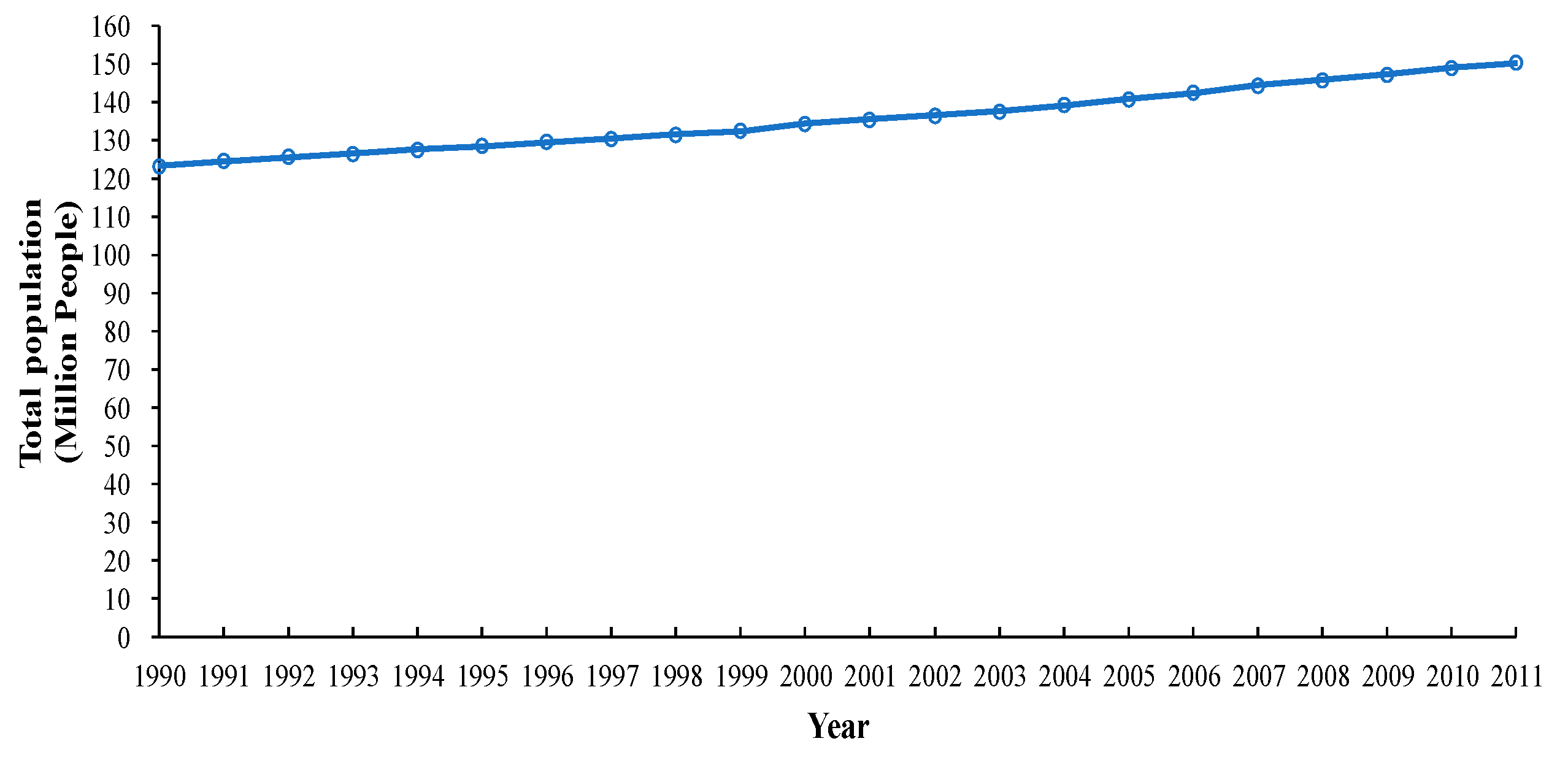
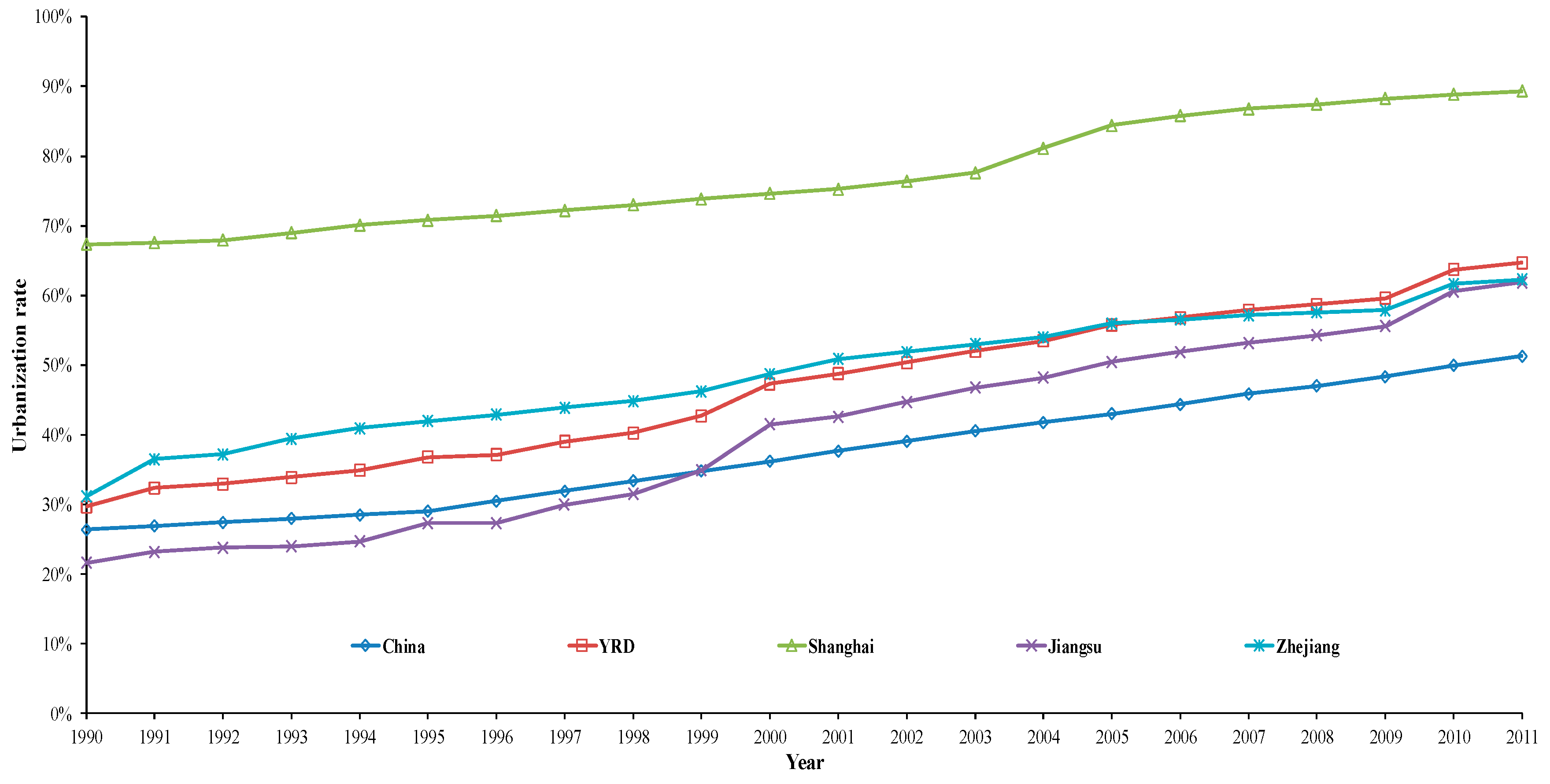
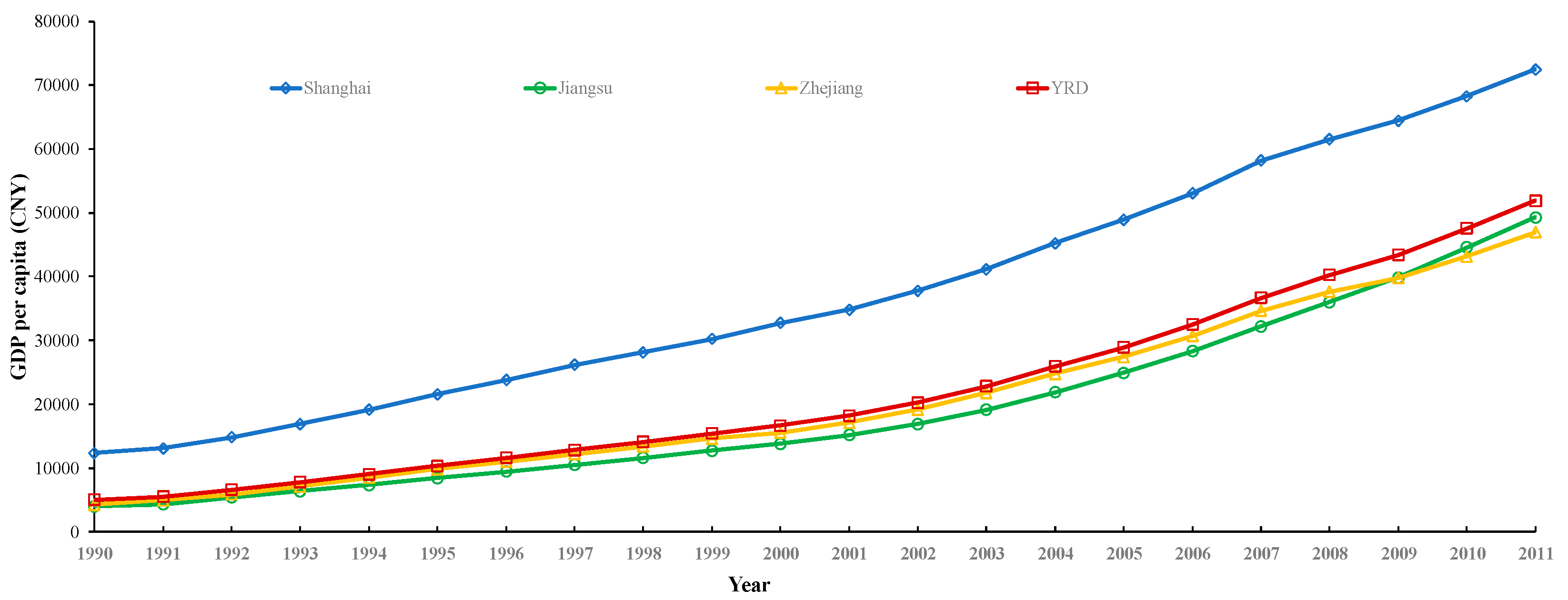
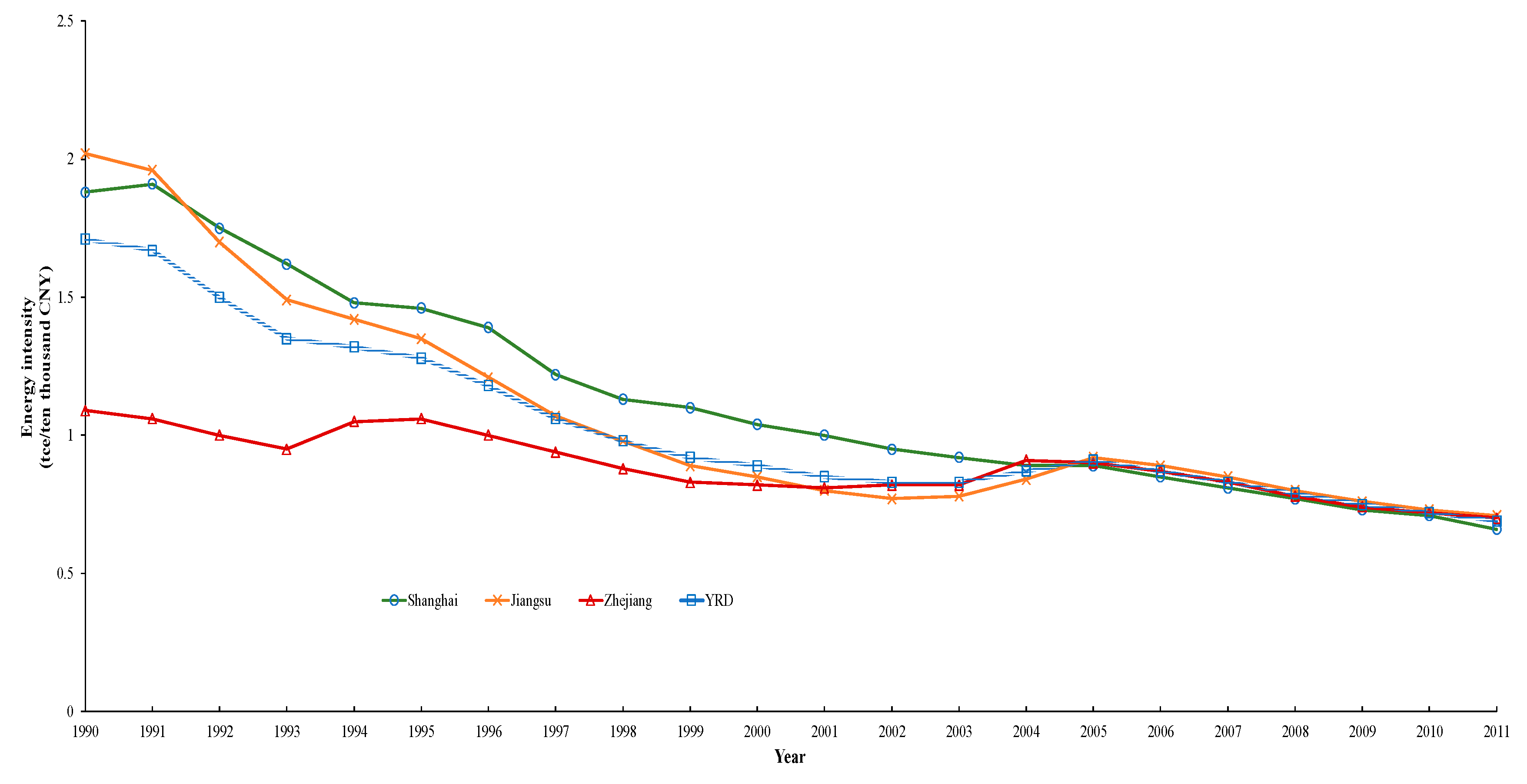
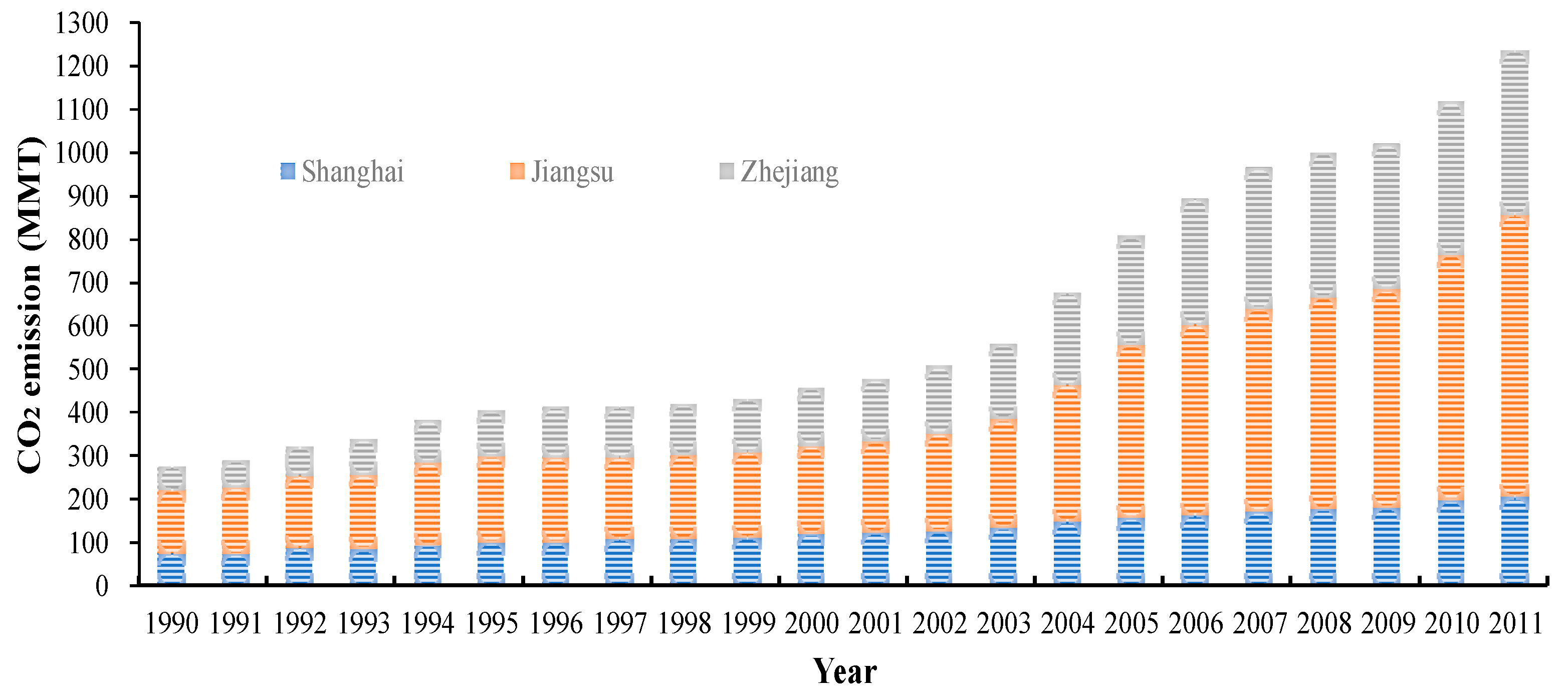

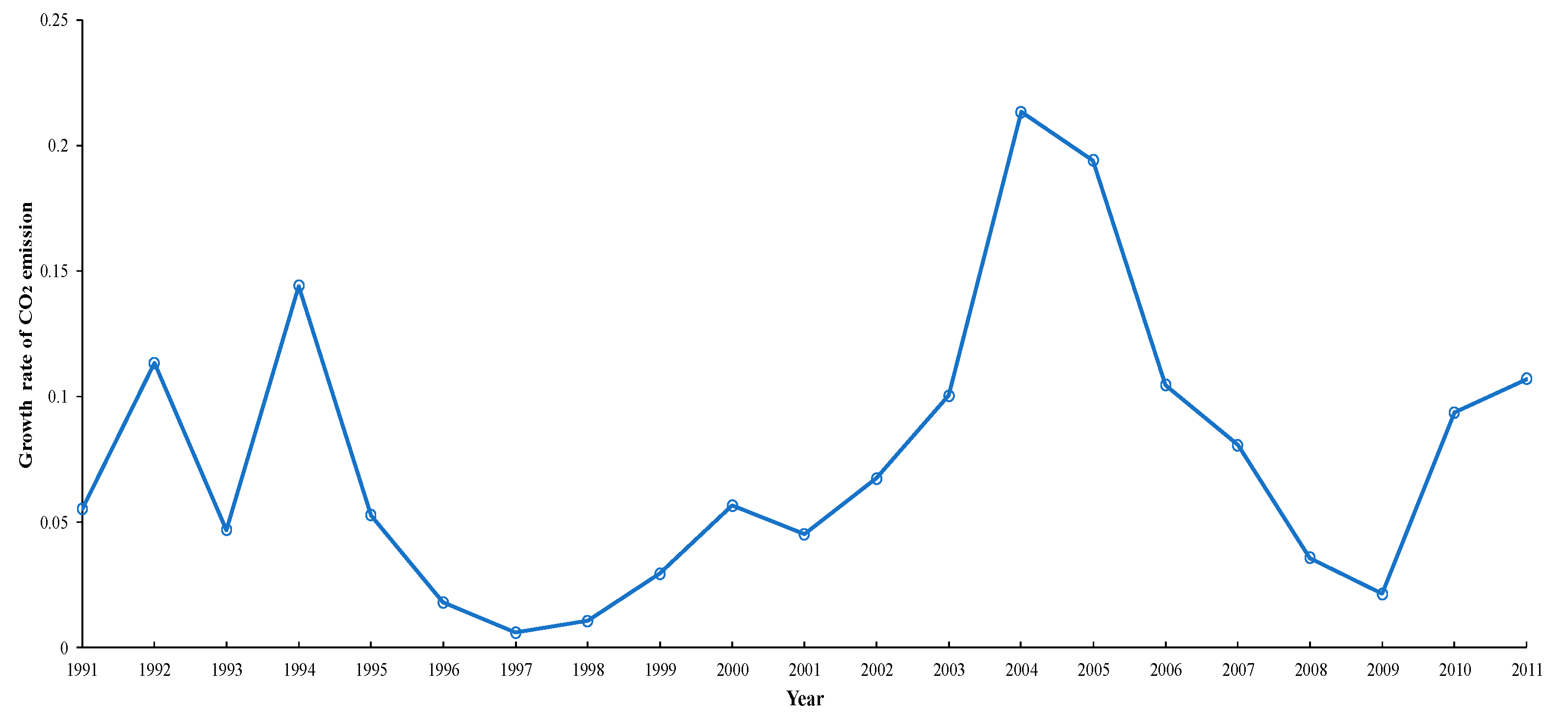

| Fuel | Ci (t/tce) | Fi |
|---|---|---|
| Raw coal | 0.7559 | 0.7143 kgce/kg |
| Washed coal | 0.7559 | 0.9000 kgce/kg |
| Coke | 0.8550 | 0.9714 kgce/kg |
| Crude oil, | 0.5857 | 1.4286 kgce/kg |
| Gasoline | 0.5538 | 1.4714 kgce/kg |
| Kerosene | 0.5714 | 1.4714 kgce/kg |
| Diesel | 0.5921 | 1.4571 kgce/kg |
| Fuel oil | 0.6185 | 1.4286 kgce/kg |
| LPG | 0.5024 | 1.7143 kgce/kg |
| Refinery dry gas | 0.4602 | 1.5714 kgce/kg |
| Natural gas | 0.4483 | 1.330 kgce/m3 |
| Series | ADF Statistics | Result | First Difference | ADF Statistics | Result |
|---|---|---|---|---|---|
| lnCARBON | 0.50 (0.98 *) | nonstationary | D(lnCARBON) | −2.61 (0.047 *) | stationary |
| lnENERTEN | −1.19 (0.65 *) | nonstationary | D(lnENERTEN) | −3.31 (0.03 *) | stationary |
| lnPERGDP | −2.64 (0.1 *) | nonstationary | D(lnPERGDP) | −2.31 (0.049 *) | stationary |
| lnPOPULATION | 2.0 (0.99 *) | nonstationary | D(lnPOPULATION) | −3.44 (0.02 *) | stationary |
| lnURBAN | −1.41 (0.55 *) | nonstationary | D(lnURBAN) | −5.03 (0.007 *) | stationary |
| Hypothesized No. of CE (s) | Eigenvalue | Trace Statistic | 0.05 Critical Value | Prob. ** |
|---|---|---|---|---|
| None * | 0.981936 | 155.4233 | 69.81889 | 0.0000 |
| At most one * | 0.846057 | 75.14633 | 47.85613 | 0.0000 |
| At most two * | 0.617977 | 37.72283 | 29.79707 | 0.0050 |
| At most three * | 0.602754 | 18.47736 | 15.49471 | 0.0172 |
| At moss four * | 0.000668 | 0.013365 | 3.841466 | 0.9078 |
| Period | S.E. | CARBON (%) | ENERTEN (%) | PERGDP (%) | POPULATION (%) | URBAN (%) |
|---|---|---|---|---|---|---|
| 1 | 0.048120 | 100.0000 | 0.000000 | 0.000000 | 0.000000 | 0.000000 |
| 2 | 0.056295 | 89.35247 | 7.132033 | 2.020358 | 0.132983 | 1.362158 |
| 3 | 0.059040 | 86.22024 | 9.546842 | 2.740183 | 0.179444 | 1.313292 |
| 4 | 0.060342 | 84.82223 | 10.11490 | 3.603223 | 0.190561 | 1.269086 |
| 5 | 0.060947 | 84.33591 | 10.18274 | 4.039191 | 0.193422 | 1.248743 |
| 6 | 0.061263 | 84.09282 | 10.14689 | 4.327790 | 0.194559 | 1.237940 |
| 7 | 0.061418 | 83.98242 | 10.10953 | 4.471183 | 0.204946 | 1.231927 |
| 8 | 0.061495 | 83.92371 | 10.08601 | 4.547782 | 0.212359 | 1.230137 |
| 9 | 0.061531 | 83.89404 | 10.07416 | 4.583483 | 0.219036 | 1.229288 |
| 10 | 0.061547 | 83.87862 | 10.06894 | 4.600212 | 0.223048 | 1.229182 |
| Year | Baseline Scenario | Energy Intensity | Urbanization Level | Per Capita GDP | Population | ||||
|---|---|---|---|---|---|---|---|---|---|
| +0.5% | −0.5% | +0.4% | −0.4% | +0.5% | −0.5% | +0.4% | −0.4% | ||
| 2015 | 1323.8 | 1324 | 1323.6 | 1325.3 | 1322.3 | 1325.9 | 1324 | 1328.8 | 1318.8 |
| 2016 | 1370.8 | 1370.9 | 1370.8 | 1372.3 | 1369.4 | 1372.9 | 1370.9 | 1375.5 | 1366 |
| 2017 | 1416 | 1416.1 | 1415.9 | 1417.4 | 1414.6 | 1418.1 | 1416.1 | 1420.4 | 1411.5 |
| 2018 | 1458.7 | 1458.8 | 1458.6 | 1460 | 1457.4 | 1460.7 | 1458.8 | 1462.8 | 1454.6 |
| 2019 | 1497.7 | 1497.7 | 1497.6 | 1498.9 | 1496.4 | 1499.5 | 1497.7 | 1501.3 | 1493.9 |
| 2020 | 1534.1 | 1534.2 | 1534.1 | 1535.3 | 1533 | 1535.7 | 1534.1 | 1537.3 | 1530.9 |
© 2019 by the authors. Licensee MDPI, Basel, Switzerland. This article is an open access article distributed under the terms and conditions of the Creative Commons Attribution (CC BY) license (http://creativecommons.org/licenses/by/4.0/).
Share and Cite
Xue, Y.; Ren, J.; Bi, X. Impact of Influencing Factors on CO2 Emissions in the Yangtze River Delta during Urbanization. Sustainability 2019, 11, 4183. https://doi.org/10.3390/su11154183
Xue Y, Ren J, Bi X. Impact of Influencing Factors on CO2 Emissions in the Yangtze River Delta during Urbanization. Sustainability. 2019; 11(15):4183. https://doi.org/10.3390/su11154183
Chicago/Turabian StyleXue, Yixi, Jie Ren, and Xiaohang Bi. 2019. "Impact of Influencing Factors on CO2 Emissions in the Yangtze River Delta during Urbanization" Sustainability 11, no. 15: 4183. https://doi.org/10.3390/su11154183
APA StyleXue, Y., Ren, J., & Bi, X. (2019). Impact of Influencing Factors on CO2 Emissions in the Yangtze River Delta during Urbanization. Sustainability, 11(15), 4183. https://doi.org/10.3390/su11154183




